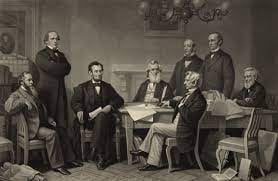GM – FBF – Today’s American Champion signed a bill Abolition in the District of ColumbiaOn April 16, 1862, President Lincoln signed an act abolishing slavery in the District of Columbia, an important step in the long road toward full emancipation and enfranchisement for African Americans.Today in our History – April 16, 1862 – President Lincoln ends abolition in the Nation’s capital.“Celebration of the Abolition of Slavery in the District of Columbia by the Colored People, in Washington, April 19, 1866.” Frederick Dielman, artist; Illus. in: Harper’s weekly, v. 10, no. 489 (1866 May 12), p. 300. The Civil War. The African American Odyssey: A Quest for Full Citizenship.This illustration from Harper’s Weekly depicts the fourth anniversary of the District’s Emancipation Act. On April 19, 1866, African American citizens of Washington, D.C., staged a huge celebration.Approximately 5,000 people marched up Pennsylvania Avenue, past 10,000 cheering spectators, to Franklin Square for religious services and speeches by prominent politicians. Two of the black regiments that had gained distinction in the Civil War led the procession.Before 1850, slave pens, slave jails, and auction blocks were a common site in the District of Columbia, a hub of the domestic slave trade. In the words of one slave who worked for a time in the District’s Navy Yard:…I generally went up into the city to see the new and splendid buildings; often walked as far as Georgetown, and made many new acquaintances among the slaves, and frequently saw large numbers of people of my color chained together in long trains, and driven off towards the South.Charles Ball, “Fifty Years in Chains or The Life of an American Slave External,” 18-19, in First-Person Narratives of the American South ExternalAs slavery became less profitable in the border states, many traders purchased slaves and shipped them to the Deep South.In cities such as New Orleans, slaves often were resold at a higher price to cotton, rice, and indigo plantation owners. Abolitionists petitioned Congress in 1828 to abolish the District’s notorious trade. Yet, despite the efforts of John Quincy Adams and others, Congress gagged discussion of the issue for nearly 20 years.In 1849, Illinois Congressman Abraham Lincoln attempted to introduce a bill for gradual emancipation of all slaves in the District. Although the District’s slave trade ended the following year, his emancipation attempt was aborted by Senator John C. Calhoun and others.As president, Lincoln was better able to effect the issue. He saw slavery as morally wrong yet held it to be an institution dying under its own weight, to be abolished by voter consent. But, as commander in chief, Lincoln also realized the military expediency of emancipation. He abolished slavery in the Capital five months prior to issuing his preliminary Emancipation Proclamation. The law he signed eventually provided District slave holders compensation for 2,989 slaves.Twenty-one years later, on April 16, 1883, Frederick Douglass spoke at a commemoration of abolition in the District. He called attention to African Americans’ continued struggle for civil rights:It is easy to break forth in joy and thanksgiving for Emancipation in the District of Columbia, to call up the noble sentiments and the starting events which made that measure possible. It is easy to trace the footsteps of the [N]egro in the past, marked as they are all the way along with blood. But the present occasion calls for something more. How stands the [N]egro to-day?Research more about this great American Champion and shear it with your babies. Make it a champion day!

